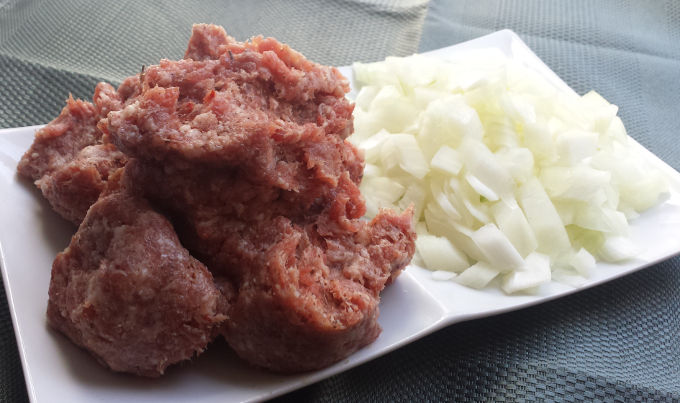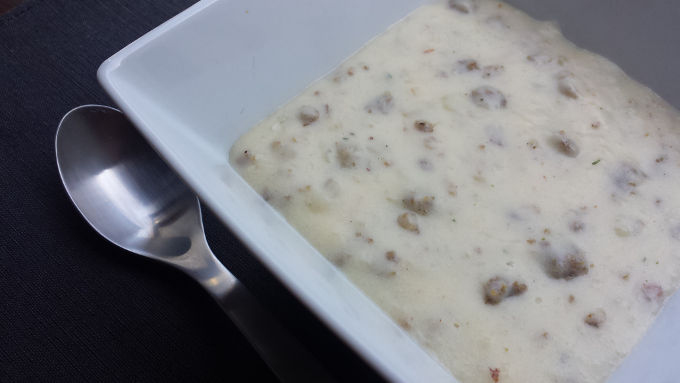
As you might know if you have read some of our other recipes, I (being Andrew) am not a fan of seafood. What does that have to do with Sausage gravy you ask? Well, not much at all, but it leads into my next thought. I should be honest and say that while I like some dishes that are popular in the south, many traditional southern dishes don’t quite do it for me. And technically I should be calling this recipe biscuits and gravy because that is what most people think of when they hear the term sausage gravy. But I’m going to leave out the part about biscuits here because you can just as easily buy a can of flaky buttermilk biscuits at the store. Unless of course you are looking to make authentic biscuits and gravy, in which case you will need to make your own biscuits from scratch.
Okay back to my previous thought. You could call me picky, but really it’s just me being too opinionated. Here’s an example. The combination of fried chicken and waffles seemed a little weird to me, so naturally I thought it was a bad idea. But I like waffles and I like fried chicken, so there shouldn’t be any reason why I wouldn’t like them together; although, I’m a little on the fence as to whether or not fried chicken would taste good drenched in syrup.
Anyway, I’m not here to talk about any of that stuff. I’m here to talk about gravy; specifically, sausage gravy, although I will talk briefly about the history of biscuits and gravy in just a minute.
In its simplest form, sausage gravy consists of nothing more than sausage, flour, milk, and maybe some salt and pepper. Indeed most recipes online only call for those handful of ingredients and that’s probably what you’re going to get when you order sausage gravy from a lot of restaurants as well. That’s by no means meant to be a blanket statement, because I know there are plenty of restaurants that do things differently. Surely it’s not that there is anything wrong with simple, and I hope I don’t come across as being critical, it’s just that I like my sausage gravy to have a little more flavor.
Speaking of flavor, I came across a recipe for biscuits and gravy that looked interesting. The gravy contains nutmeg, Worcestershire sauce, and sage sausage. It’s definitely more unique than a lot of the recipes I found online. Here’s the link: Buttermilk biscuits and sausage gravy. Needless to say, there’s a recipe for biscuits on that website if you don’t feel like being lazy and buying them in a can from the store like me. Check it out and see what you think.

Buttermilk biscuits are delicious and taste even better when liberally covered in sausage gravy. I would include a recipe for biscuits on this page, but like I said earlier, I don’t think it’s necessary at this time because I want to focus on the sausage gravy. Besides, there are other things you can top with the gravy besides biscuits, it just so happens that that is the most common choice. However, chicken fried steak and mashed potatoes immediately come to mind as other popular favorites as well.
Early European settlers to America employed a simple style of cooking, with many dishes based around ground wheat, meat, and gravy. And when the first unfortunate pigs where brought from England to Jamestown, Virginia in 1608 the rest is history you could say, because they became quite popular as delicious edible animals. And they still are to this day. Sorry to any vegetarians out there.
The dish which is most commonly known as “biscuits and gravy” really started to become popular in the south after the American Revolutionary War in the late 1700’s. At that time the food stocks were limited but breakfast had to be the most substantial meal of the day, when one was to spend the entire day working on the plantations. Lack of money and supplies meant the meal had to be cheap but filling. And as an added bonus, it tasted pretty good too.
One method that people use is to fry the sausage and then add flour right in to the pan with the grease and sausage before adding the milk. I’m not sure how well this works since I prefer to make a roux to thicken the gravy, but it seems to thicken just fine according to them. I only say that because I was taught to make it by creating a roux first, even though it makes a couple extra dishes that need to be washed at the end.
The only other things I do differently are to add some diced onion in with the sausage as it cooks, a couple drops of Tabasco sauce, and some chicken bouillon to give it extra flavor. Be careful that you don’t add too much chicken bouillon because that can easily make this dish too salty, in which case you will need to thin it out with additional milk. And like always, the recipe below will make enough sausage gravy to feed a small army. I really need to work on my portions. You could halve the recipe and be just fine.
With that being said, I hope you enjoy the recipe and share it with others. Let us hear your thoughts about this recipe too.

A most delicious looking serving of biscuits and gravy. Better than what you’ll get in the restaurants.
Sausage Gravy
By: Semiserious chefs
Serves: 8-10
Ingredients:
- 1 lb breakfast sausage (you can use spicy, maple, or sage if you prefer)
- 1/2 medium onion or about 1 cup onion (diced)
- 8 cups milk
- 1 cup hot water
- 4 tablespoons chicken bouillon
- Tabasco sauce (just a few drops)
- 1-1/4 cups all purpose flour
- 1/2 cup vegetable oil
Directions:
- Before you begin, make sure the saucepan you will be using can hold at least 3 quarts. If you don’t have a saucepan that large, you will need to adjust the recipe accordingly.
- Add the pound of breakfast sausage to the large saucepan, and brown over medium heat for roughly 5 minutes or until the sausage is about 3/4 of the way cooked.
- Add onions and finish cooking until the sausage is fully cooked. Maybe another minute or two.
- Pour in 8 cups of milk and give it a good stir. If you noticed I didn’t drain the sausage or use the grease for roux, it’s because there won’t really be much grease and draining it would eliminate some of the flavor we want.
- In a measuring cup, blend the chicken bouillon with one cup of hot water and add to the milk.
- Keep heat at medium until it comes to a simmer.
- While the milk and sausage mixture is slowly heating, add a few drops (or more if you like) of Tabasco sauce.
- In another pan add the vegetable oil and turn the heat up to medium-hi. Add the flour and stir with a whisk. If you are using a nonstick pan, be sure to use a rubber whisk so you don’t scrape up your pan.
- If the roux is too crumbly you might need to add a little more vegetable oil until it stops clumping together.
- Stir the roux frequently to avoid burning. Cook 3 – 4 minutes or until it just starts to slightly brown.
- Carefully pour all the roux into the large saucepan that has the milk and sausage. Again be careful because the roux will be very hot.
- Depending on how hot the milk is, the gravy should start thickening a few moments after the roux is poured in. If it doesn’t seem to be thickening very much, it could be that the milk isn’t warm enough. As long as the milk is simmering, the roux should work quickly.
- Serve over biscuits or whatever else you want and enjoy!


Post a comment